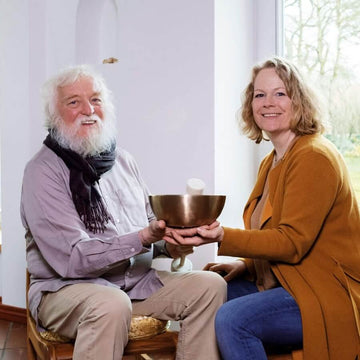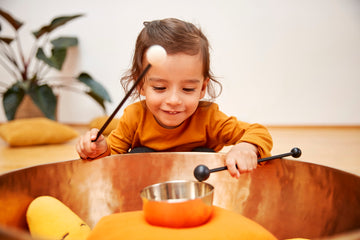Children are also attracted to harmonious sounds. The sound and gentle vibration of Singing Bowls can be used in a variety of ways to promote perception, relaxation, increase concentration and strengthen social skills. This is why Singing Bowls and forms of sound therapy for children can now be found in many families, kindergartens and schools, in children's yoga and in occupational therapy practices.
The most important facts in brief
- One of the aims of sound therapy for children is to promote relaxation, concentration and attention.
- The best way for children to learn about Singing Bowls is through play. They offer a lot of potential for this.
- Just like for adults, there are also singing bowl massages for children.
- In an educational context, Singing Bowls games can be played with children in a variety of ways.
What is the aim of Singing Bowls therapy for children?
Peter Hess, the founder of sound massage with Singing Bowls, has developed the training system "KliK® - Sound Communication" together with his wife Emily Hess. This teaches children how to relax. Singing bowl therapy for children trains sensory and body awareness, promotes attention and concentration and practises mindfulness. This provides children with important resources that enable them to cope with the diverse demands of our fast-paced world, stay physically and mentally healthy and maintain their zest for life and creativity.
Sound therapy for children can pursue a variety of goals. For example, the promotion of:
- Relaxation
- Concentration
- Attention
- Motivation
- Imagination and creativity
- Sensory and body awareness
- Perception of own needs and those of others
- Expression of feelings
- Self-confidence and joie de vivre

How can I bring children closer to Singing Bowls ?
Children often perceive Singing Bowls as something special and valuable - especially when it is introduced by adults. One way of introducing a Singing Bowl to children is to hide it under a cloth in a special place, for example. First, the children can reach under the cloth with their eyes closed and guess what they can guess and what can be done with it. Once the secret is revealed, you try to make the bowl sound together.
Singing, nudging or filling
Children are often wonderfully relaxed and open-minded when dealing with Singing Bowls . The instrument can be made to sound in a variety of ways and not just the traditional way with a mallet. Children can also sing to Singing Bowls and it sings along; you can gently nudge it with your fingers and it sighs softly; you can fill it with beads that swoosh back and forth like the waves of the sea. And the great thing about it is that it always sounds different. Sometimes the sounds are deep and long-lasting, sometimes they are high and only sound for a very short time.
"Children are our future. If we treat them with respect and appreciation and offer them opportunities to develop freely and joyfully, we will have laid the foundations for a peaceful future."
Peter Hess
Apply to the body, place inside or fill with water
Children can also place a Singing Bowl on their stomach or another part of their body and if the bowl is big enough, you can even stand in it. When it is then struck, it tingles. If you are quiet and listen carefully, you will realize how long a Singing Bowl can sound. It's also fun if you fill the bowl with water and hit it hard - this creates a real "sound fountain".
Experiments with fingers and mallets
What does it sound like when you tap the bowl with the ball of your hand or when your fingernails dance over it? What does it sound like when you tap it with a felt mallet or with a friction mallet, a rubber mallet or when you swing grains of sand or lentils back and forth in it? There are no limits to your imagination here, try out whatever comes to mind for you and the children. Anything goes - except sharp or hard objects that could damage the surface. After a while, let the Singing Bowl sound properly for the first time and ask the children to listen to the sound - not just with their ears, but with their whole body.

Are there singing bowl massages for children?
Yes, as with a normal sound massage, in a singing bowl massage for children Therapy Singing Bowls are positioned on or around the body according to a specific system and gently tapped. Adults and children alike usually enjoy the subtle tingling of the sound vibrations and the gentle fading of the harmonious sounds during a sound massage from the very first moment, which quickly leads to relaxation. Feelings of contentment, serenity and inner peace often set in.
What happens during a singing bowl massage for children?
During a singing bowl massage for children, the body is loosened by the sounds and the mind comes to rest - the soul is given space to unfold. The vibrations that emanate from the sounding and thus vibrating bowls gradually spread through the skin, tissue, organs, body fluids and body cavities throughout the entire body. Our body, which consists of around 70 percent fluid, reacts sensitively to this subtle stimulation. The sounds literally set it in motion, in flow. The fine vibration impulses gently loosen muscular tension and adhesions in the fascial tissue and stimulate blood circulation and lymph flow.
Many people describe their experience during a sound massage as "a kind of very fine cell massage" that has a soothing effect deep into the body. For children, the sound massage sometimes feels like the "tingling of a thousand rays of sunshine in the stomach". In general, the following effects can be summarized.
The sound massage:
- is a holistic method that addresses body, soul and spirit
- causes deep relaxation
- strengthens people's original trust
- makes it easier to "let go" - of worries, fears and doubts
- contributes to health promotion: Harmonization, regeneration and vitalization
- supports and improves body and self-awareness
- contributes to the activation of self-healing powers
- Enables access to and use of own resources
- strengthens self-confidence, creativity, creative power and motivation
How long does a sound massage for children take?
A classic sound massage takes about an hour, including a preliminary discussion and rest. Various short sound massage offers have been designed for working with children - depending on the age and personality of the child. Such sound massages for children are taught, for example, in the seminar "Sound massage with children - a new experience of touching all the senses with children". The seminar builds on the training seminar "Sound massage I - strengthening your own center" and teaches many variations of the classic basic sound massage especially for children. Of course, children or teenagers can also give each other a little sound massage - or their parents, which fills the little ones in particular with pride.
Many adults are always amazed at the sensitivity and attentiveness that children show during a sound massage. Here too, every experience is individual and can vary greatly from child to child.
Sound and fantasy journeys with children
Children love sounds and children love fantasy journeys and stories - so what could be more natural than combining these two elements to create sound-based fantasy journeys? Children usually reach a state of deep relaxation much faster than adults and at the same time follow the text very consciously. They often experience and live through the imaginative stories in the moment.
The sounds not only promote relaxation and strengthen attention, but also have a positive effect on concentration, memory and stamina. Selected imaginary journeys can help children to better process inner tensions, fears and experiences and thus become a valuable resource in terms of coping with life and self-confidence.
"Imagination is more important than knowledge, because knowledge is limited. But imagination encompasses the whole world."
Albert Einstein

Singing Bowls-Games with children in an educational context
The diverse Singing Bowls games with children, sound exercises and sound settings can be ideally integrated into educational plans and curricula. They enrich the respective educational concepts and, as a non-verbal medium of communication and expression, help to overcome language or cultural barriers in a playful way. Accordingly, they have also proven their worth as a complementary offer in integrative facilities. Educators, teachers and parents not only appreciate the beneficial effect on children and the general atmosphere, but also the fact that they themselves benefit from the sounds. The Singing Bowls games with children also become valuable relaxation phases for them in their often stressful and noisy everyday lives.
"In order to stabilize the huge potential of networking possibilities in the brain as well as possible and to allow our children's innate talents to develop, we need to give them the opportunity to play for as long as possible."
Gerald Hüther
Sound breaks in kindergarten
Children are often exposed to many stimuli that they are not always able to filter or process adequately. A relatively high noise level is part of everyday life in kindergarten - some children cope better with this, others less so. Large groups of up to 25 children pose a particular challenge for the little ones. Teachers who face these stressors themselves on a daily basis know a thing or two about this. This is where small sound breaks, which repeatedly lead to calm, focus attention and bring everyone involved into contact with themselves, are particularly beneficial.
The intensive training course to become a KliK® expert/practitioner - sound communication with children, which is primarily aimed at educational or therapeutic professionals, offers extensive information and practical tips.
Sound as support in everyday school life
The desire to learn and grow is inherent in all of us from the very beginning. It is not always easy to preserve the natural joy of learning, because social influences and the idea of performance have an impact on the learning process from an early age. A lack of concentration, high expectations and pressure to perform have an impact on pupils, parents and teachers and quickly lead to dissatisfaction, tension and stress. KliK® aims to create a counterbalance here, offering relaxation, supporting the joy of learning and helping to strengthen concentration and stamina. The focus is always on the personal development of children and young people, on identifying and cultivating resources that can provide them with lasting support on their path through life.
Singing BowlsGames with children and other sound activities can be used not only in the classroom, but also in working groups, after-school care, school social work or by school psychologists.
Whether in primary or secondary school, experience shows that sound methods are a useful addition to the teaching process. They can be used in different situations and with different objectives, for example:
- Use of Singing Bowls for learning motivation and better learning
- Learning with all senses
- Sound rituals and sound innovation (at the beginning of lessons, during lessons, during breaks, before tests or exams, at the end of the day)
- Promoting concentration
- Supporting integration and inclusion with sound
- Strengthening social learning and mindfulness
- Support in dealing with conflict situations






